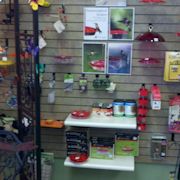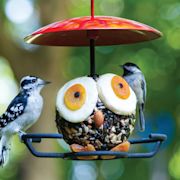Search results
Wild Birds Unlimited specializes in bringing people and nature together through the hobby of backyard bird feeding, nature products and local expert advice.
Explore more than 800 North American bird species, learn about their lives and habitats, and how climate change is impacting their ability to survive.
Learn how to identify birds by using clues, tips, guides, and rules from Audubon experts. Find out the differences between similar species, such as raptors, warblers, finches, and more.
- Northern Cardinal
- Blue Jay
- Steller's Jay
- Mourning Dove
- American Crow
- European Starling
- Northern Mockingbird
- Black-billed Magpie
- Dark-Eyed Junco
- Black-Capped Chickadee
With its black face and crimson crest, beak, and body, the male Northern Cardinal, or “redbird” to many, is one of the most recognized and well-known birds in North America. Though less showy, females are also splendid, wearing soft, tawny feathers instead of the male's bright red plumage. Cardinals are often in pairs and can be seen at feeders and...
As with the cardinal, it’s pretty darn hard to mistake a Blue Jay for anything else. A distinctive bird that can be seen year-round in the eastern United States, the Blue Jay is of one of the most striking—and loudest—jays. At home in the forest, they also thrive in suburban habitats and are often unfairly (or, okay, fairly) regarded as feeder bull...
When you reach the Rocky Mountains, suddenly Blue Jays are replaced by Steller's Jays. With their contrasting blue lower bodies and black backs, heads, and crests, Steller's are easily distinguishable. Loud and boisterous, they are most common in coniferous forests, but as with all jays, these birds are bold and have grown accustomed to humans, mak...
The most widespread dove in North America, the Mourning Dove is an easily startled ground feeder that can be found pretty much anywhere with open habitat, from woodlands to cities. Note the uniform brown-gray coloring, dark spots on the wings, light-blue eye ring, and sharp, pointed tail. These doves can also easily be identified by their woeful co...
Sure, you know what a crow looks like. But do you know whattype of crow you’re looking at? Often found in a variety of semi-open habitat, American Crows are large, all-black birds that can easily be identified by their harsh caw! call, which knowing is key to differentiating the American Crow from the almost-identical-looking Fish Crow and Northwes...
Talk about a bird that’s truly everywhere. Walk outside, look around, and chances are good you’ll see a starling. An introduced species to the U.S., these birds are now omnipresent—much to the disadvantage of many other species. Often found in huge flocks in the winter and fall, this medium-size forager sports a spiky yellow bill and richly detaile...
You've definitely heard a Northern Mockingbird before. You know that bird that keeps you up in the middle of the night with its endless stream of songs? That's a mocker. One of the most common suburban birds across the U.S., the Northern Mockingbird is a master mimic, able to imitate hundreds of birds' songs and calls. With their gray bodies marked...
A staple of the American West, this large bird is hard to miss with its black head and back, white breast, long tail, and iridescent feathers. Members of the corvid family along with crows, jays, and ravens, magpies can be found at all elevations in urban and rural habitats, often strutting around open areas foraging for food. The Black-billed Magp...
Juncos are a popular and widespread winter visitor to almost all of the United States from the boreal forests of the North and high mountains. They prefer mixed woods and coniferous habitat, but they are staples of backyards, where they bounce around under feeders foraging and eating spilled seeds. The eastern version of the junco—the dark-eyed one...
A permanent resident across the northern U.S. and in parts of the Appalachian Mountains, Black-capped Chickadees are energetic little birds that prefer mixed, open woods and forest edges. Easy to identify by their white cheeks sandwiched between a black cap and chin, chickadees also live in suburban environments and are popular feeder visitors, whe...
- Andrew Del-Colle
Learn about different types of wild birds, how to attract and feed them, and how to build birdhouses and bird baths. Find tips and ideas for creating a hummingbird garden and more.
birding, and opportunities to help bird conservation. Use our Bird Guide to identify birds, learn about the life history, listen to the sounds, and watch bird behavior on video--the most comprehensive guide to Nort.
Find and learn about 600+ North American bird species with photos, sounds, and life history info. Browse by family or shape, or use Merlin Bird ID app to identify birds by sight or sound.




